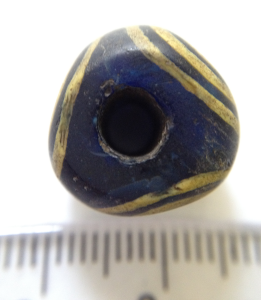
It’s occurred to me with all these posts about beads, I have yet to write a post that actually defines what a bead is. That’s a bit surprising, given how often people ask me this question, so here’s a post on what they actually are. It’s more complicated than you might think.
Definitions I use:
Generally speaking, I define a bead as an object that can be strung and that has either a single, central perforation or multiple perforations that are centred within the object.
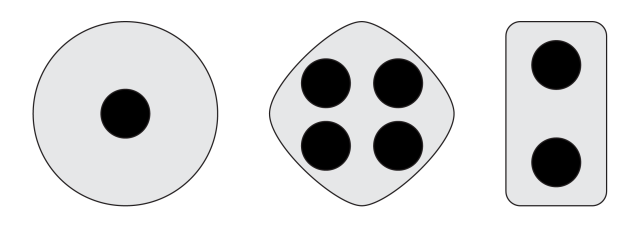
A pendant is decidedly not a bead. Pendants generally are objects that can be strung, but they tend to have a perforation that is offset from the centre:
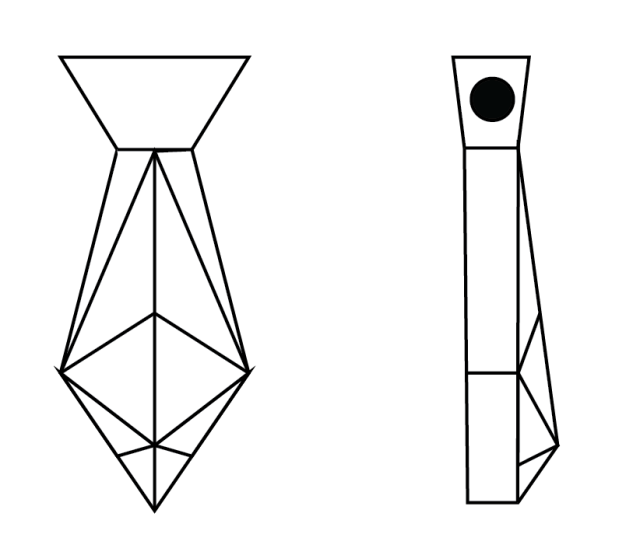
Problems with these definitions:
This seems relatively straightforward, but there are actually multiple problems with these definitions. First, just because an object CAN be strung, doesn’t mean it was. I always refer back to the ancestor statue I saw in the National Museum of Indonesia, but it’s useful for dispelling a lot of stereotypes about beads. Neither of the beads on this statue were strung, and yet they are still beads. But if stones had been placed in the same spot for the same purpose, they would be decidedly not beads. Yes, I said a bead was an object that could be strung, not one that absolutely was, but it still calls into question one of the most common function-based definitions of a bead.
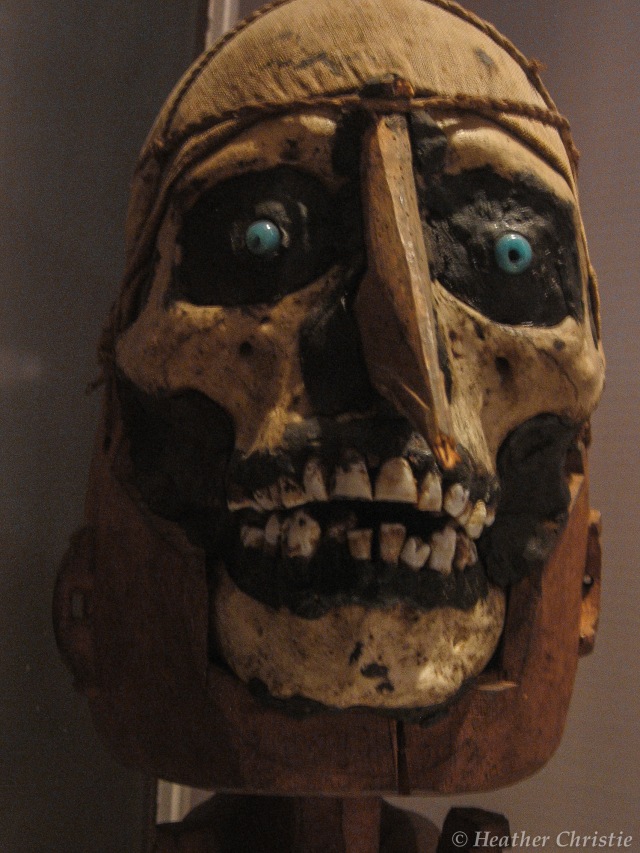
Seed beads in the eye sockets of an ancestor statue on display at the National Museum in Jakarta, Indonesia.
Second, there are many objects with a central perforation or with multiple centred perforations that are not beads. Spindle whorls are the main ones I encounter in Scotland. These are generally stone or ceramic objects with a central perforation that are attached to a rod and used to spin yarn. Weights, particularly loom weights, are another difficult object when it comes to beads. Many weights have a central perforation, particularly those used for weighing down the warp (verticle) threads on a loom. Both spindle whorls and loom weights tend to be larger that a bead, as more weight is usually needed for both spinning and weaving. Yet, if the desired thread from spinning or the thread used in weaving is particularly fine, the spindle whorls or loom weights can become quite small – small enough to be a bead. I should also note that there is technically no size limit on a bead, so they can easily be as large as a typical spindle whorl.
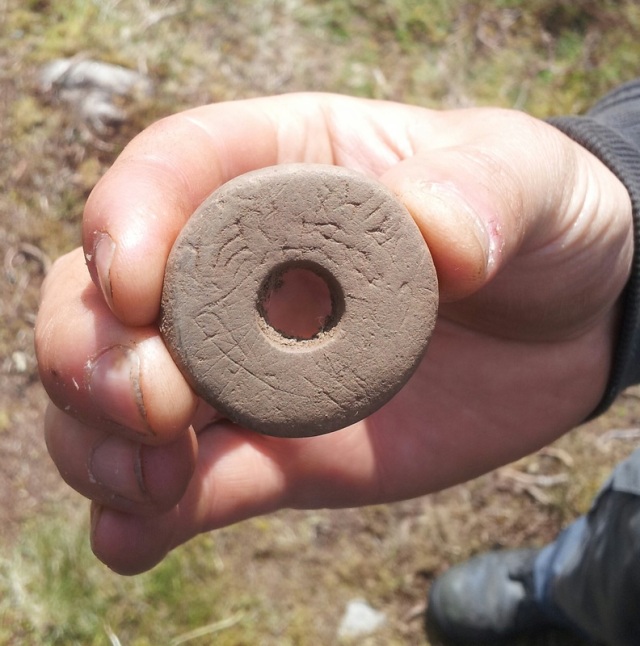
Spindle whorl from Lair, Scotland. © PKHT / Northlight Heritage, http://www.glenshee-archaeology.co.uk/news/finds-report-on-the-lair-spindlewhorl-out-now
Buttons are also objects with centred perforations. In modern times, we tend to differentiate between beads and buttons by saying that buttons fasten something closed, while beads are generally decorative. Buttons are functional. But many buttons aren’t functional, even in modern times, and many beads aren’t purely decorative. Even if they were, we generally can’t distinguish between them in older archaeological contexts unless they are still clearly associated with other objects. Most beads I see are stray finds, making it largely impossible to differentiate between objects defined by their function.
Third, many objects used as pendants have a central perforation. Archaeologically, we might call it a large bead, a spindle whorl, or a loom weight, but it may have been used as a pendant. Pendants are generally larger objects that are strung to hang in a central or prominent way, and if it has a single, central perforation, it hangs so that you see the perforation. But this definition once again relies on function. Without associated objects or individuals, we can’t necessarily tell if a larger centrally perforated object was a spindle whorl, a loom weight, a pendant, or a bead.
Fourth, just because an object has a perforation doesn’t mean it could ever have been strung. I have seen objects with perforations that are far too small to string on anything thicker than a single strand of hair (such as the model below), rendering the object fairly useless as a bead. I have also seen glass pressed around a rod, pin, or other rounded object. When the object was in use, the glass would be considered a decoration, but not a bead. When the glass cracked, it retained the circular ‘perforation’ of the rod or pin, but the object never really served as a bead.
The net result is that defining a bead is relatively simple if you don’t need to technically differentiate it from a lot of other things. If you need to tell the difference between a bead, a spindle whorl, a loom weight, a pendant, or an interesting decoration, however, then defining a bead is rather difficult. So while I use the above definitions in my work, I am keenly aware of the possible issues with that definition.


dear Heather Christie
if you join the Bead Society of Great Britain (founded 1989) you will be just in time to attend our annual AGM!
http://www.beadsociety.org.uk
our members include craftspeople, archaeologists, collectors, designers, researchers, curators, lecturers…
our internationally recognised outstanding journal includes: discussions, reviews, informative and stimulating articles and illustrations of all aspects of the subject of beads.
Stefany Tomalin, co-founder/member.
Hi Stefany – I will gladly join, as I have been meaning to for some time. I can also try to attend the AGM, but it will depend largely on my ability to find funding for travel expenses! Thank you very much for the invite, and I hope to see you in July!
Dear Heather, Your essay is a great example of “reinventing the wheel”—since this is a topic that has been essayed and exposited numerous times, just during my fifty years of dealing with beads. Notably by Peter Francis, Jr. and myself (at different times and various arenas/venues). Plus, I would alert you to the Classification System, composed by Horace Beck in 1927, in which he defined a pendant as (paraphrasing) ‘a sort of bead.’ While I cannot agree with you entirely, most of this would be sparring about presentation, rather than content. Plus I’d correct your typos. I’d love to meet you, should I get to Glasgow. Good luck. Jamey D. Allen – Bead Historian
Hi Jamey, I would certainly never claim to be the first person to discuss the issue of bead classification. I have also spent a decade studying beads archaeologically and am very aware of Beck’s and Francis’s terminology. I didn’t really intend on going into all of those here, largely because this is a blog, and the post was meant to highlight issues in defining beads for those who don’t necessarily have access to those academic works (especially since many are out of print!). I’ll consider writing a follow-up that contains the numerous definitions of beads that have been discussed over the years (Francis, Beck, yourself, but also van der Sleen, Guido, Callmer, Brugmann, and countless others) – I just felt that would result in a very long initial post. I’d be happy to meet with you, should you ever come to Glasgow.